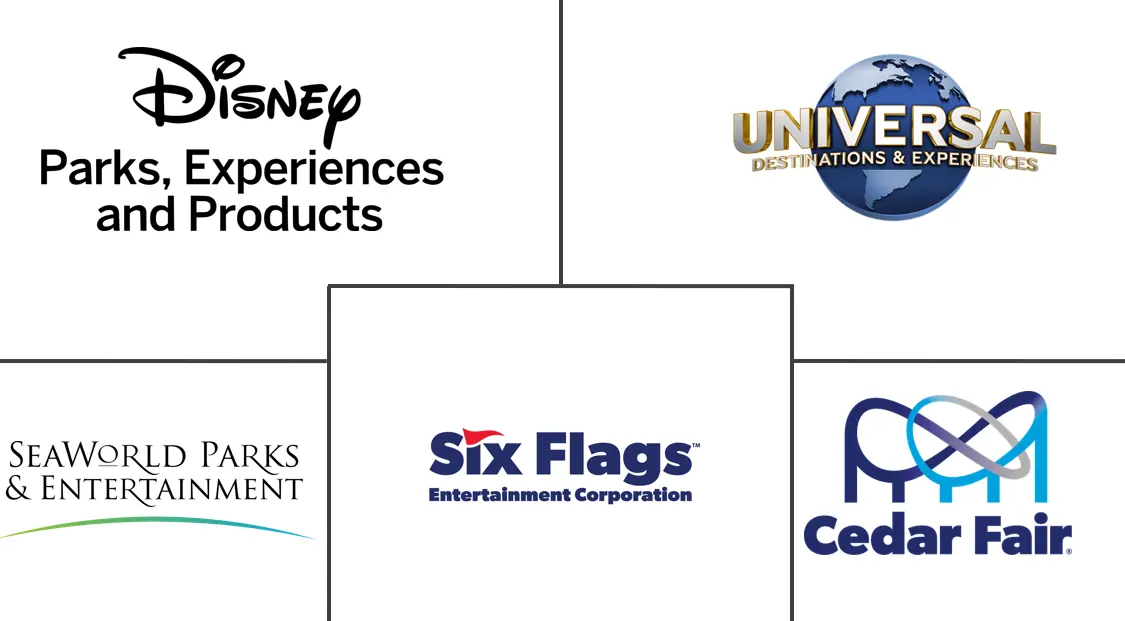United States Amusement And Theme Park Industry Size and Share
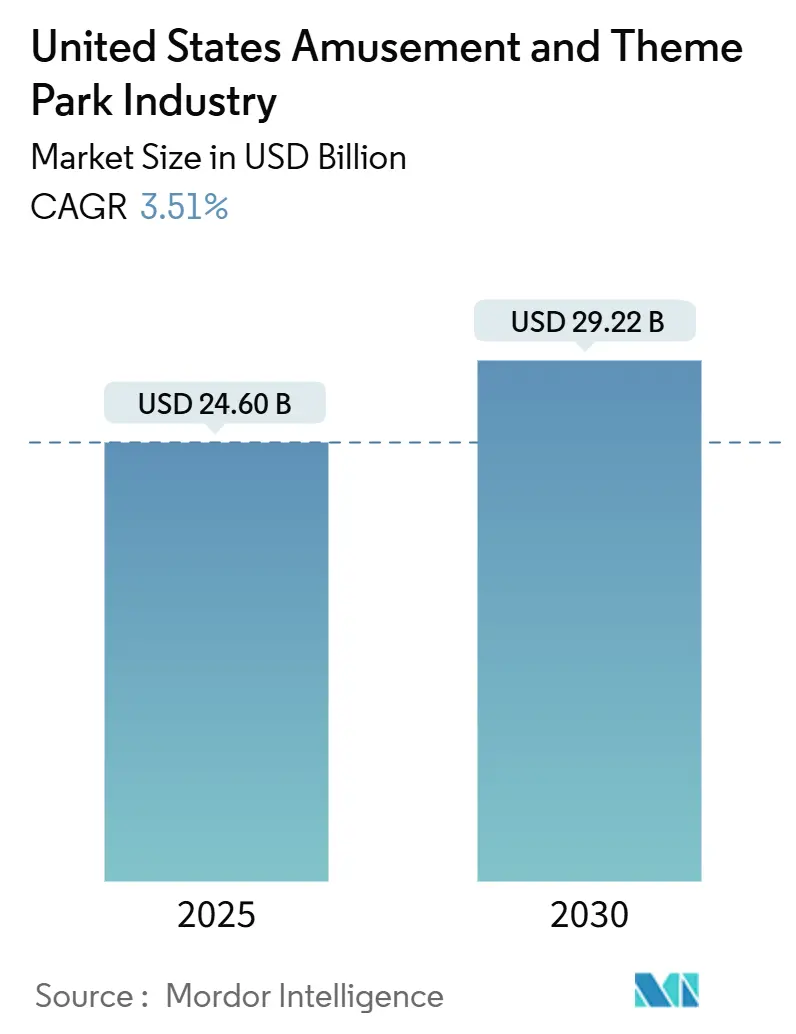
United States Amusement And Theme Park Industry Analysis by Mordor Intelligence
The US Amusement and Theme Park Industry is valued at USD 24.6 billion in 2025 and is forecast to reach USD 29.22 billion by 2030, reflecting a steady 3.51% CAGR. The outlook signals durable demand despite macro-economic pressure, largely because operators channel capital toward premium, story-driven attractions and technology that widens per-capita spend. Development has moved well past ride counts, with destination parks layering resorts, dining districts, and intellectual-property (IP) zones that convert once-per-season visitors into multi-day vacationers. Digital queuing, mobile commerce, and data-driven pricing are further lifting yields in real time, while indoor formats give chains a hedge against weather volatility. Consolidation, most notably the 2024 Six Flags–Cedar Fair merger, accelerates these shifts by pooling capital expenditure and marketing power on a national scale.
Key Report Takeaways
- By park type, theme parks held 61% of the US amusement and theme parks industry share in 2024; indoor entertainment centers are expanding at a 7.8% CAGR through 2030.
- By ride type, land rides accounted for 54% of the US amusement and theme parks industry size in 2024, whereas hybrid/dark rides are projected to grow at 9.2% CAGR to 2030.
- By source of revenue, tickets contributed 54% of the 2024 turnover of the US amusement and theme parks industry, while merchandise leads growth with an 8.6% CAGR outlook to 2030.
- By region, the southeast US captured 43% of the 2024 revenue of the US amusement and theme parks industry; the West US is advancing at a 6.1% CAGR through 2030.
- Disney Parks, Universal Destinations & Experiences, Six Flags-Cedar Fair, and SeaWorld hold a substantial amount of shares in the 2024 revenue.
United States Amusement And Theme Park Industry Trends and Insights
Drivers Impact Analysis
| Drivers | (~) % Impact on CAGR Forecast | Geographic Relevance | Impact Timeline |
|---|---|---|---|
| Growth in Consumer Spending & Disposable Income | + 0.7% | National, with stronger effects in Southeast and West regions | Medium term (2-4 years) |
| Surge in season-pass and subscription program adoption stabilising year-round gate traffic | + 0.8% | National, with early gains in Northeast and Midwest | Short term (≤ 2 years) |
| Flagship IP integrations widening demographic appeal and boosting per-capita spend | + 0.6% | National, concentrated in major destination markets (Orlando, Southern California) | Medium term (2-4 years) |
| Record pipeline of new high-thrill coaster installations (2024-2026) driving first-time and repeat visitation | + 0.5% | National, with concentration in regional parks | Short term (≤ 2 years) |
| Resort-style park expansions capturing multi-day guest spend | + 0.6% | Southeast (Orlando) and West (Southern California) | Medium term (2-4 years) |
| Increase in Domestic and International Tourism | + 0.4% | Southeast, West, and Northeast | Medium term (2-4 years) |
| Source: Mordor Intelligence | |||
Growth in Consumer Spending & Disposable Income
Household out-of-home entertainment budgets rebounded quickly once pandemic restrictions eased, and robust wage growth in 2024-2025 kept momentum intact even as inflation remained elevated. Higher-income cohorts are gravitating toward VIP tours, skip-the-line bundles, and chef-led dining that lift average guest outlays. American Hotel & Lodging Association data show total guest spending across lodging and allied leisure segments climbing to USD 777.25 billion in 2025, a level that funnels more discretionary dollars toward park vacations. Operators reinvest these gains into headline attractions that carry premium surcharges, creating a positive feedback loop of quality and pricing power that supports the US amusement parks market even during softer attendance weeks.
Surge in Season-Pass and Subscription Program Adoption
Shift-to-subscription underpins a structural change in revenue mix: instead of volatile single-day tickets, parks now bank predictable cash flows, often collected months before a ride opens. Large chains report that passholders visit on average 5–6 times per year, smoothing weekday foot traffic and boosting in-park spending on food, retail, and paid experiences. Vail Resorts’ Epic Pass, which supplies 64% of total lift revenue, validates the model’s durability in allied sectors. In the US amusement parks market, pass databases also feed AI recommendation engines that personalize offers, nudging spend without aggressive discounting. Regional parks in the Northeast already see weekday staffing efficiencies because predictable passholder demand allows tighter labor scheduling.
Flagship IP Integrations Widening Demographic Appeal
High-profile franchises such as Harry Potter, Nintendo, and Star Wars expand reach beyond core thrill-seekers by tapping multigenerational fandom. Universal’s Epic Universe debuts in May 2025 with five IP-rich lands that bundle rides, shows, and retail into cohesive story arcs. The approach supports higher per-capita merchandise spend and repeat visitation sparked by limited-edition events timed to new film or game releases. Disney’s segment results corroborate the lift: parks produced 59% of corporate operating income in 2024, even though they accounted for a smaller revenue share [1]Source: The Walt Disney Company, “Fiscal 2024 Annual Report,” thewaltdisneycompany.com. Smaller chains counterbalance by licensing mid-tier brands or focusing on local sports IP, but barriers to headline franchises remain high.
Record Pipeline of New High-Thrill Coaster Installations
From 2024-2026 the construction slate includes more than two dozen major coasters, many exceeding 200 ft in height or integrating launch technologies that generate social-media buzz. Six Flags-Cedar Fair earmarked USD 1 billion for new rides, with seven coasters already green-lit for 2025. Enthusiast communities track record attempts in real time, delivering organic reach that depresses traditional marketing cost per guest. Hybrid wood-steel designs broaden appeal to families by trading extreme g-forces for smoother cycles, extending rider eligibility and throughput. The surge provides regional parks a branding tool that counters the year-round pull of indoor centers in urban malls.
Restraints Impact Analysis
| Restraint | (~) Impact of CAGR Forecast | Geographical Relevance | Impact Timeline |
|---|---|---|---|
| Rising wage inflation and persistent frontline labour shortages escalating operating costs | -0.6% | National, with acute impact in West and Northeast | Short term (≤ 2 years) |
| Escalating cap-ex requirements for ride refurbishment and ASTM/OSHA safety compliance | -0.4% | National | Medium term (2-4 years) |
| Ticket-price growth outpacing CPI, limiting accessibility for middle-income families | -0.5% | National | Medium term (2-4 years) |
| Increasing frequency of weather-related closures disrupting peak-season operations | -0.5% | Southeast (hurricane exposure), Midwest and Northeast (winter weather) | Long term (≥ 4 years) |
| Source: Mordor Intelligence | |||
Rising Wage Inflation and Labor Shortages
Hourly pay for frontline roles has climbed sharply in 2023 as parks compete with retail and hospitality employers that raised wages to attract scarce talent. Government data show seasonal H-2B visa cap requests far exceeding the 66,000 annual limit, leaving many operators understaffed during spring break and Halloween peaks [2]Source: Federal Register, “Improving Tracking of Workplace Injuries and Illnesses; Final Rule,” federalregister.gov. Labor now represents 30–40% of expenses at mid-sized venues, pressuring EBITDA margins. Chains are piloting self-serve food kiosks, mobile order lockers, and compact merchandise vending to reallocate workers to value-added guest interaction. California’s ride-safety unit requires operators to document staffing levels for inspections, adding complexity for West Coast parks. Smaller independents without scale for automation face the sharpest profitability squeeze, which may spark further consolidation within the US amusement parks market.
Increasing Frequency of Weather-Related Closures
Climate trends deliver more volatile rainfall in the Southeast and deeper freeze cycles in the Midwest, chopping operational days and inflating insurance premiums. Hurricane Idalia forced multiday closures in Florida during 2024, while February ice storms shaved two weekends from early-spring openings in Ohio. Operators add indoor pavilions, convertible queue roofs, and year-round dark rides to cushion gate swings, yet cap-ex payback stretches longer when projects focus on resilience over headline thrills. Insurers demand updated catastrophe models, raising underwriting costs that feed into ticket pricing. As the frequency of closures edges higher, parks must design calendars that push special events into shoulder months to reflate lost revenue days.
Segment Analysis
By Park Type: IP Integration Drives Destination Appeal
Theme Parks generated USD 15.0 billion in revenue in 2024, equal to 61% of the US amusement parks market size, underscoring their outsized role in shaping nationwide growth. New lands anchored by household franchises keep visit frequency high, while on-site hotels capture ancillary spend over multi-day stays. The model creates a flywheel: hotel occupancy funds premium builds that raise daily ticket yields, which in turn finance more hotel keys. Water Parks, though operating on leaner budgets, leverage local repeat traffic and bundling with nearby resorts to sustain 3% annual expansion.
Indoor Entertainment Centers posted only USD 2.1 billion in 2024 but are rising fastest at 7.8% CAGR. Year-round climate control, modest square-foot requirements, and adjacency to urban malls cut weather risk and widen audience reach beyond peak summer break. Chains adapt augmented-reality (AR) games to re-theme arenas overnight, refreshing content without heavy construction. Adventure and Thrill Parks remain essential for teen and young-adult cohorts seeking coaster milestones, yet they increasingly share wallet with boutique indoor attractions. Animal & Marine Parks continue a measured trajectory as conservation mandates add fixed cost, though educational programming and rescue partnerships create goodwill that supports premium behind-the-scenes tours.
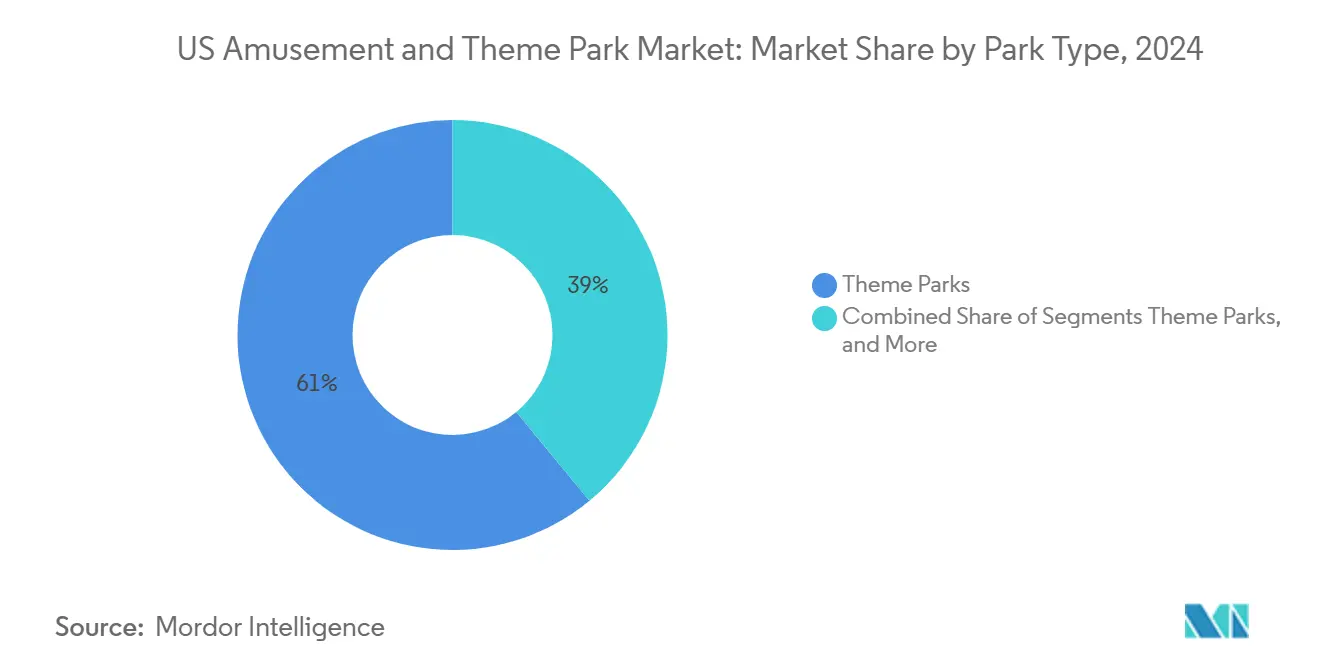
Note: Note: Segment shares of all individual segments are available upon report purchase
By Ride Type: Technology Enhances Traditional Experiences
Land Rides delivered USD 13.3 billion in revenue in 2024, representing 54% of the US amusement parks market size, and remains the promotional linchpin for most gate campaigns. Operators stagger opening dates across spring breaks and summer to elongate marketing windows. Water Rides, accounting for 21% of 2024 turnover, benefit from Southern and coastal climates but require higher water and energy inputs that expose them to utility-price swings.
Hybrid/Dark Rides climbed 9.2% in 2024 alone, the sharpest gain among categories, as parks fused trackless vehicles with projection-mapping to craft repeat-friendly narratives attuned to diverse language audiences. Capacity averages 1,800 guests per hour, mitigating queue frustration and lifting in-park spend. Integration with mobile apps allows riders to unlock digital collectibles, creating new micro-transactions. Simulation-based Other Rides, such as flying theaters and motion platforms, serve as filler attractions that absorb midday crowds, allowing anchor coasters to reset queues for evening peaks.
By Source of Revenue: Diversification Beyond Gate Receipts
Tickets generated USD 13.3 billion, equal to 54% of operator intake, yet their share is edging downward as ancillary lines accelerate. Dynamic-pricing engines adjust daily rates based on weather forecasts, local school calendars, and competitor promotions, yielding 4–6% incremental lift. The US amusement parks market has seen subscription penetration top 40% of attendance at several regional chains, dampening same-day ticket volatility.
Merchandise grew 11% year-over-year during 2024, the highest among revenue streams, propelled by limited-edition IP drops and on-ride photo bundles. Operators redesign exit paths to channel guests through themed shops, raising capture rates to upper 80-percentile levels. Food & Beverage keeps stable mid-teens growth by pairing chef partnerships with mobile pre-ordering, which lifts per-capita ticketless spend. Ancillary Services, such as preferred parking and paid lockers, provide quick-return cash flows that finance future attraction cycles.
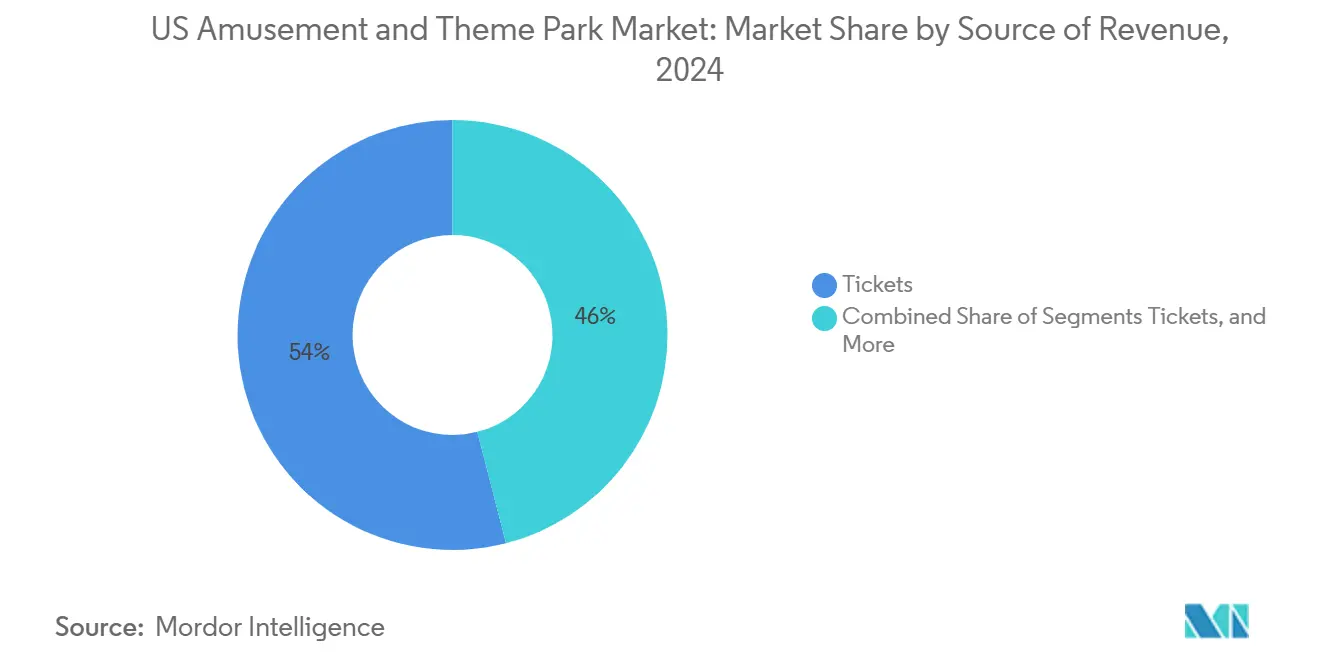
Note: Note: Segment shares of all individual segments are available upon report purchase
By Age Group: Multi-Generational Appeal Drives Growth
Families with children under 12 years accounted for 38% of attendance in 2024, reflecting the enduring pull of character meet-and-greets and family-friendly dark rides. Teenagers contributed 22% of foot traffic, gravitating to record-setting coasters and shareable moments that dominate social feeds. Young Adults aged 19-35 years deliver the highest per-capita spend, especially on evening hard-ticket events and craft beverage programs.
Adults aged 36-55 years typically control travel budgets, making their perception of value critical. Parks craft tiered offerings—standard, express, VIP—to satisfy varied price elasticity within this segment. Accessibility upgrades, such as wider queue lanes and companion-assist devices, enhance goodwill and lengthen dwell time. Balancing thrill intensity, comfort amenities, and nostalgia content across these cohorts is central to sustaining repeat intent within the US amusement and theme park market.
Geography Analysis
The Southeast, anchored by Orlando, produced 43% of 2024 revenue, buoyed by 74 million visitors and a climate that supports year-round operations. The opening of Epic Universe in 2025 adds 750 acres of capacity, fortifying the region’s dominance. Brightline’s inter-city rail extension links Miami to Orlando International Airport, enlarging the day-trip catchment. Hotels surrounding International Drive posted occupancy rates above 78% in 2024, giving parks confidence to keep ADR-pegged ticket bundles in place. The US Amusement and Theme Park Market size in the Southeast will likely top USD 13 billion by 2030, reflecting deep capital pipelines and favorable tourism policy.
The West accounted for 23% of revenue but is projected to grow at 6.1% CAGR, the quickest among all regions. Southern California benefits from two-airport international connectivity and a resident population inclined toward frequent entertainment spending. Disney earmarked up to USD 17 billion for Disneyland enhancements, including mixed-use expansion that turns the resort into a four-day destination. Northern California golf-and-park packages and Las Vegas’ indoor attraction build further diversify offerings in the broader West.
The Northeast holds roughly a 1/4 % share, constrained by shortened operating seasons yet supported by dense metro populations with high discretionary income. Bundles pairing season passes with public-transport discounts cater to New York and Boston commuters. Midwest parks collectively hold 1a 2% share; prolonged winters limit calendars, but nostalgia events and fall festivals augment season length. The Southwest rounds out the map at 8%, with Phoenix and Dallas-Fort Worth projects such as Mattel Adventure Park signaling room for first-time entrants. Each region adapts capital deployment and marketing cadence to climate and travel-pattern realities, reinforcing the geographic mosaic within the US Amusement and Theme Park Market.
Competitive Landscape
Disney Parks and Universal Destinations & Experiences continue to define the high-end destination tier through expansive IP catalogs and sustained cap-ex above USD 5 billion annually. Disney’s parks produced USD 34.15 billion in revenue and USD 9.27 billion in operating income during fiscal 2024 [3]Source: The Walt Disney Company, “Fiscal 2024 Annual Report,” thewaltdisneycompany.com. Universal counters with Epic Universe and aggressive technology rollouts, such as facial-recognition entry that compresses gate queues. Both chains funnel proprietary streaming content into physical attractions, creating brand ecosystems difficult to replicate.
The Six Flags-Cedar Fair merger reshaped the regional tier, consolidating 42 parks under one banner and yielding procurement savings on food, uniforms, and ride parts. The new entity leverages a 26-million passholder database to cross-promote between markets, raising occupancy at under-utilized properties. SeaWorld, rebranded as United Parks, pivots toward thrill rides to offset debate around marine mammals, recently opening a competitive launch coaster in San Antonio.
Smaller independents and family-owned venues survive by exploiting niche themes, flexible pricing, and community loyalty, yet rising safety-compliance costs may push some toward strategic alliances or asset sales. Technology deployment emerges as a fresh battleground: AI-driven guest routing, variable-rate parking, and micro-fulfillment retail tie directly to unit economics. The TEA/AECOM Theme Index shows parks that kept building during 2020-2021 downturn recovered faster by 2024, a “spend-through-the-cycle” mentality is now table stakes. Intellectual-property scarcity, capital intensity, and labor demands together shape a competitive matrix in which size and storytelling differentiate winners in the US Amusement and Theme Park Market.
United States Amusement And Theme Park Market Leaders
-
Disney Parks, Experiences and Products
-
Universal Destinations & Experiences
-
Six Flags Entertainment Corporation
-
Cedar Fair L.P.
-
SeaWorld Parks & Entertainment, Inc.
- *Disclaimer: Major Players sorted in no particular order
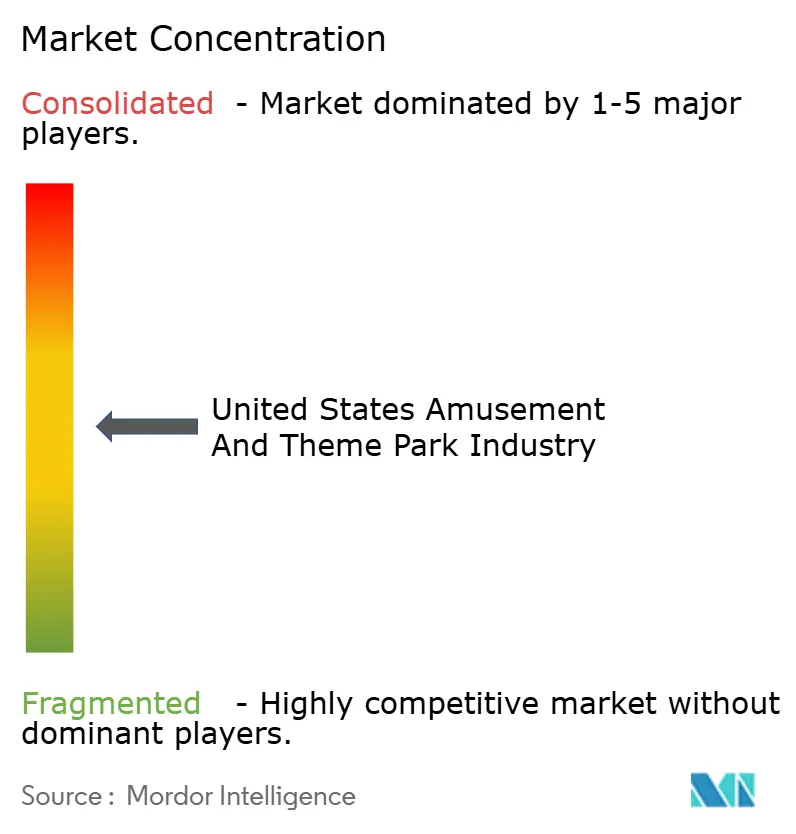
Recent Industry Developments
- April 2025: Slick City inaugurated its Houston indoor slide park, extending the chain to 10 facilities as part of a franchise strategy targeting nationwide mall redevelopments.
- January 2025: Disney announced plans to develop its first new international resort in 15 years, located in Abu Dhabi, following fiscal 2024 results where parks supplied 59% of operating income.
- January 2025: Universal Orlando opened Epic Universe, a 750-acre park with five IP-driven lands anchored by new Wizarding World of Harry Potter and Super Nintendo World zones, representing a USD 7.7 billion investment.
- November 2024: Six Flags-Cedar Fair confirmed a USD 1 billion two-year capital program, allocating funds to seven new coasters, food-service overhauls, and park-wide Wi-Fi upgrades.
Research Methodology Framework and Report Scope
Market Definitions and Key Coverage
Our study defines the United States amusement and theme park market as all fixed-site facilities that operate permanent mechanical, water, hybrid, and experiential rides alongside themed shows, food, retail, and on-site events. A theme park is treated as a subset that organizes the guest journey around a unifying intellectual property, story line, or cultural motif, while general amusement parks offer mixed attractions without a central theme. According to Mordor Intelligence, the market generates revenue only when the spend occurs inside the gated park perimeter or its directly managed digital channels.
Scope exclusion: Travelling carnivals, single-ride attractions, independent family entertainment centers, and hotel revenue booked outside park ownership are not counted.
Segmentation Overview
- By Park Type
- Theme Parks
- Water Parks
- Adventure Parks / Thrill Parks
- Animal & Marine Parks
- Indoor Entertainment Centers
- By Ride Type
- Land Rides
- Water Rides
- Hybrid / Dark Rides
- Other Rides
- By Source of Revenue
- Tickets
- Food & Beverages
- Merchandise
- Hospitality (Lodging & Events)
- Ancillary Services (Parking, Photos, Fast-Pass, etc.)
- By Age Group
- Children (< 12 Years)
- Teenagers (12-18 Years)
- Young Adults (19-35 Years)
- Adults (36-55 Years)
- Seniors (> 55 Years)
- By Region
- Northeast
- Southeast
- Southwest
- West
- Midwest
Detailed Research Methodology and Data Validation
Primary Research
Mordor analysts maintain rolling interviews with park finance managers, ride OEM sales heads, food-service concessionaires, state tourism officials, and insurance underwriters across Florida, California, Ohio, and Texas. These conversations test preliminary assumptions on gate price strategy, attendance elasticity, and downtime patterns, and they fill gaps that published statistics leave unanswered.
Desk Research
We start with federal and industry-body data such as the U.S. Bureau of Labor Statistics QCEW establishment counts, Bureau of Economic Analysis recreation output tables, and U.S. Travel Association leisure spend trends, which ground visitation and spend ceilings. Attendance audits from the Themed Entertainment Association, accident and inspection filings from state safety regulators, and patent activity on ride systems accessed via Questel help us gauge installed ride base and pipeline. Public company filings mined through D&B Hoovers, plus earnings call transcripts retrieved on Dow Jones Factiva, supply park-level revenue splits. These sources set boundary conditions before primary inputs are layered. The sources mentioned illustrate our approach and are not an exhaustive list of references used.
Market-Sizing & Forecasting
A top-down construct ties historical attendance, average ticket, food, and merchandise spends to produce the 2024 base, which is then bridged to 2025. Results are corroborated with bottom-up checks using sampled operator revenues and ride-cycle throughput models. Key variables include per-capita disposable income, domestic leisure trip volume, announced new-ride capacity, inflation-adjusted gate pricing, and seasonal weather disruption days; each is forecast through multivariate regression and ARIMA routines that capture near-term shocks and longer consumer trends. Gaps in smaller operator data are filled through attendance proxies derived from mobile location analytics shared by regional tourism boards.
Data Validation & Update Cycle
Outputs pass three analyst reviews, where variances above preset thresholds trigger re-contact of interviewees and source rechecks. Models are refreshed every twelve months, with interim revisions when mergers, regulation, or extreme weather materially shift demand. A final pre-publication sweep ensures clients receive the latest calibrated numbers.
Why Our United States Amusement And Theme Park Industry Size & Share Analysis Baseline Commands Reliability
Published figures vary because firms adopt different inclusion rules, exchange-rate dates, and refresh cadences.
We acknowledge these gaps upfront and explain them so decision-makers can anchor confidently.
Benchmark comparison
| Market Size | Anonymized source | Primary gap driver |
|---|---|---|
| USD 24.6 B (2025) | Mordor Intelligence | - |
| USD 28.4 B (2024) | Regional Consultancy A | Counts resort lodging and indoor FECs not within our scope |
| USD 34.1 B (2024) | Industry Journal B | Uses NAICS 71311 data that bundles arcades and county fairs |
| USD 36.9 B (2030) | Global Consultancy C | Applies forward CAGR to a broader 2024 base that already included ancillary hotel revenue |
The comparison shows how scope creep, older baselines, or optimistic growth multipliers inflate totals. By selecting only in-park revenue streams, validating prices with operators, and updating every year, Mordor Intelligence delivers a balanced, transparent baseline that planners can trace back to clear variables and repeatable steps.
Key Questions Answered in the Report
What is the current value of the US Amusement and Theme Park Market?
The market stands at USD 24.6 billion in 2025 and is projected to reach USD 29.22 billion by 2030.
Which segment is fastest growing under park type?
Indoor Entertainment Centers are expanding at a 7.8% CAGR due to weather-independent, year-round operations.
How significant are season-pass programs for park revenue?
Subscription and pass products now account for more than 40% of attendance at several major chains, stabilizing cash flow and boosting in-park spend.
What geographic region leads US Amusement and Theme Park Market revenue?
The Southeast, anchored by Orlando, generates 43% of national revenue and benefits from a year-round operating calendar.
How has the Six Flags-Cedar Fair merger affected the market?
The deal created a 42-park portfolio that pools marketing and procurement, intensifying competition with destination giants while elevating overall market concentration.
Page last updated on:
